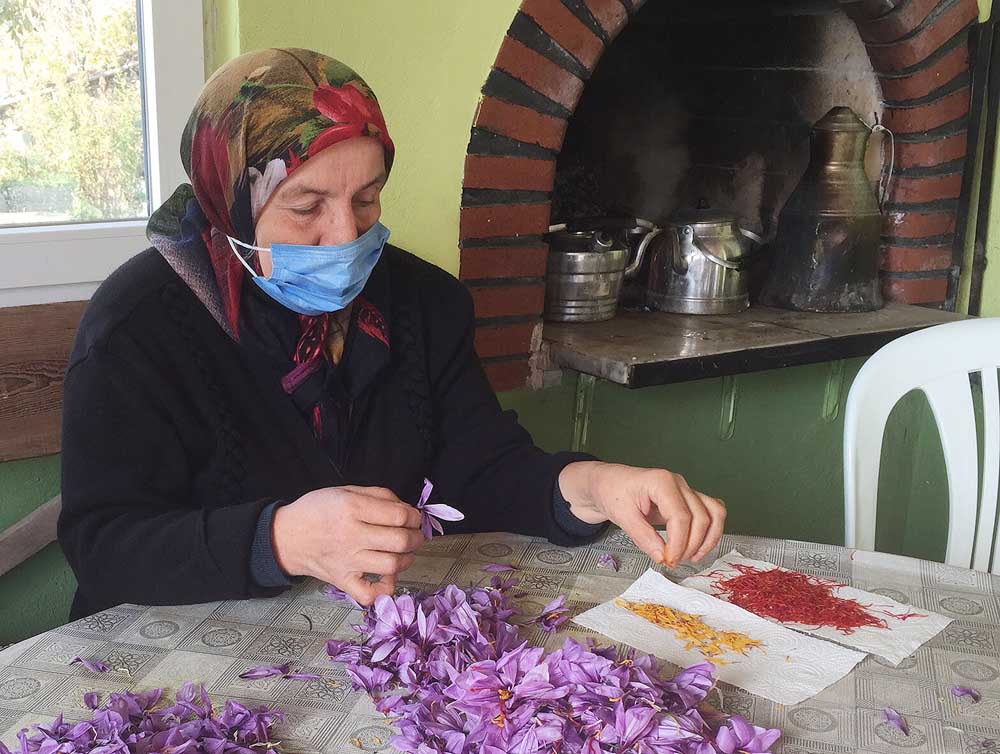Saffron harvest underway in Turkish city
Published 8:00 am Wednesday, November 10, 2021

- Fatma Turhan processes saffron flowers after harvest.
SAFRANBOLU, Turkey — On autumn mornings between Oct. 15 and Nov. 15, workers arrive before dawn to painstakingly hand-pick the bright purple flowers that bejewel Ismail Yilmaz’s hillside farm in Safranbolu, Turkey.
By afternoon, they sit in front of piles of the flowers and carefully pluck the vivid crimson and yellow stigmas from the center. Once the stigmas have dried in the sun, they become saffron. With a distinct color, flavor and hay-like scent, saffron is used in cuisine, perfume, dyes and increasingly, medicine. Due to its ability to dye anything a brilliant yellow and its mood-boosting properties, it’s sometimes referred to as the “sunshine spice.”
The meticulous, labor-intensive cultivation and harvest combined with a low yield per acre make saffron the most expensive spice in the world by far.
An acre of saffron flowers, known as Crocus sativus, yields an average of just 4 pounds of saffron, and 170,000 flowers produce just 1 pound of the spice, according to the North American Center for Saffron Research and Development at the University of Vermont.
A pound costs roughly $5,000; the second most expensive spice is vanilla at $600 per pound, according to Business Insider.
Iran produces about 90% of the world’s saffron, followed by India, Greece, Afghanistan, Morocco and Spain, according to Statista, a German market research firm.
In Turkey, saffron production is unique to Safranbolu, a World Heritage Site near the famous historical spice trade route known as the Silk Road.
The city has a long history of saffron production. Its name literally means “having plenty of saffron.”
That was true historically: Records from the Ottoman Empire show that Safranbolu exported 21,385 pounds of saffron to England in 1858.
For reasons that are unclear, production had dwindled to only a few small farms in one village in Safranbolu by the 1990s. But in the early 2000s, Safranbolu’s saffron production experienced a sort of revival.
With the help of Turkey’s Ministry of Agriculture and Forestry, the Safranbolu District Agriculture and Forest Directorate began an education program to encourage and assist more farmers in growing saffron.
Today, just 14.3 acres in the historical city are planted to the flowers, yielding about 55-65 pounds of saffron per year, said Mehmet Emre, district agricultural manager at the directorate.
Turkey does not formally export saffron, as it doesn’t produce enough to meet domestic demand.
However, some companies from countries such as the U.S., Indonesia, Kuwait and Qatar come to Safranbolu to purchase large quantities. In 2018, Yilmaz sold saffron to the Maryland-based spice company, McCormick, via a third-party broker.
While Safranbolu saffron strands can travel the world, Turkish law bans the export of Safranbolu Crocus sativus plants to preserve the product’s special flavor and aroma.
The Crocus sativus corm, or its underground stem, is planted on the last day of August, cultivated in cow manure, and harvested about 40 days later. Each corm produces seven to eight bulbs. The corm can bloom for three years and then has to be replanted to a new field so the former location can fallow, Yilmaz said.
With relatively low rainfall, Safranbolu’s climate and clay loam soil are well suited to grow the plant, which is resistant to cold temperatures and can tolerate summer heat of up to 113 degrees Fahrenheit, according to a 2017 study by Karabuk University in the International Journal of Geography and Geology.
The saffron fields have become a tourist attraction. A few years ago, the city started holding an annual saffron harvest festival in the autumn. Local merchants peddle saffron-scented hand sanitizers, perfumes and lotions as well as saffron-infused coffee, tea and confections called Turkish delights.
Globally, there is growing interest in saffron, not just as an agent of color, taste and scent, but as an ingredient for pharmaceuticals. According to Healthline, recent research is beginning to confirm ancient beliefs that saffron can boost the mood, treat depression, reduce blood pressure, lower cholesterol and relieve the symptoms of premenstrual syndrome and holds the potential for treating Alzheimer’s and Parkinson’s diseases and cancer.
In the U.S., researchers like those at the University of Vermont are working with farmers to attempt to grow saffron in new locations such as in that northeastern state.






